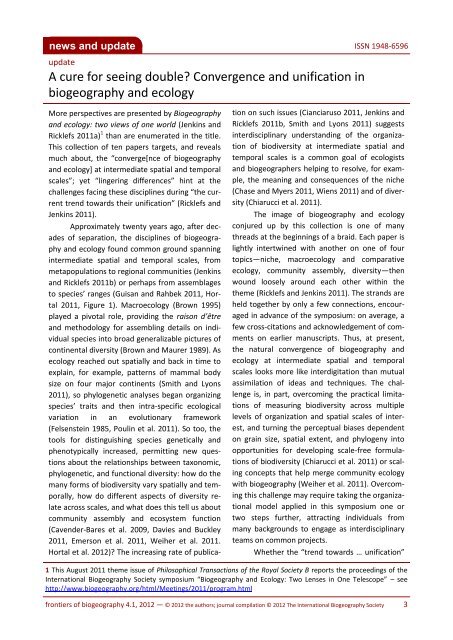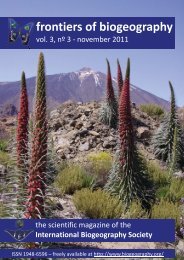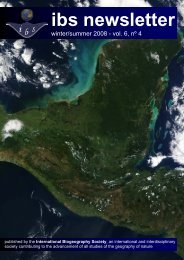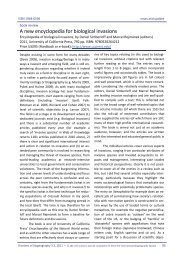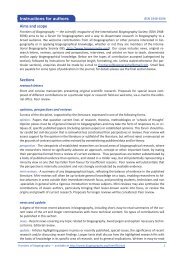1 - The International Biogeography Society
1 - The International Biogeography Society
1 - The International Biogeography Society
- No tags were found...
You also want an ePaper? Increase the reach of your titles
YUMPU automatically turns print PDFs into web optimized ePapers that Google loves.
news and update ISSN 1948-6596updateA cure for seeing double? Convergence and unification inbiogeography and ecologyMore perspectives are presented by <strong>Biogeography</strong>and ecology: two views of one world (Jenkins andRicklefs 2011a) 1 than are enumerated in the title.This collection of ten papers targets, and revealsmuch about, the “converge[nce of biogeographyand ecology] at intermediate spatial and temporalscales”; yet “lingering differences” hint at thechallenges facing these disciplines during “the currenttrend towards their unification” (Ricklefs andJenkins 2011).Approximately twenty years ago, after decadesof separation, the disciplines of biogeographyand ecology found common ground spanningintermediate spatial and temporal scales, frommetapopulations to regional communities (Jenkinsand Ricklefs 2011b) or perhaps from assemblagesto species’ ranges (Guisan and Rahbek 2011, Hortal2011, Figure 1). Macroecology (Brown 1995)played a pivotal role, providing the raison d’êtreand methodology for assembling details on individualspecies into broad generalizable pictures ofcontinental diversity (Brown and Maurer 1989). Asecology reached out spatially and back in time toexplain, for example, patterns of mammal bodysize on four major continents (Smith and Lyons2011), so phylogenetic analyses began organizingspecies’ traits and then intra-specific ecologicalvariation in an evolutionary framework(Felsenstein 1985, Poulin et al. 2011). So too, thetools for distinguishing species genetically andphenotypically increased, permitting new questionsabout the relationships between taxonomic,phylogenetic, and functional diversity: how do themany forms of biodiversity vary spatially and temporally,how do different aspects of diversity relateacross scales, and what does this tell us aboutcommunity assembly and ecosystem function(Cavender-Bares et al. 2009, Davies and Buckley2011, Emerson et al. 2011, Weiher et al. 2011.Hortal et al. 2012)? <strong>The</strong> increasing rate of publicationon such issues (Cianciaruso 2011, Jenkins andRicklefs 2011b, Smith and Lyons 2011) suggestsinterdisciplinary understanding of the organizationof biodiversity at intermediate spatial andtemporal scales is a common goal of ecologistsand biogeographers helping to resolve, for example,the meaning and consequences of the niche(Chase and Myers 2011, Wiens 2011) and of diversity(Chiarucci et al. 2011).<strong>The</strong> image of biogeography and ecologyconjured up by this collection is one of manythreads at the beginnings of a braid. Each paper islightly intertwined with another on one of fourtopics—niche, macroecology and comparativeecology, community assembly, diversity—thenwound loosely around each other within thetheme (Ricklefs and Jenkins 2011). <strong>The</strong> strands areheld together by only a few connections, encouragedin advance of the symposium: on average, afew cross-citations and acknowledgement of commentson earlier manuscripts. Thus, at present,the natural convergence of biogeography andecology at intermediate spatial and temporalscales looks more like interdigitation than mutualassimilation of ideas and techniques. <strong>The</strong> challengeis, in part, overcoming the practical limitationsof measuring biodiversity across multiplelevels of organization and spatial scales of interest,and turning the perceptual biases dependenton grain size, spatial extent, and phylogeny intoopportunities for developing scale-free formulationsof biodiversity (Chiarucci et al. 2011) or scalingconcepts that help merge community ecologywith biogeography (Weiher et al. 2011). Overcomingthis challenge may require taking the organizationalmodel applied in this symposium one ortwo steps further, attracting individuals frommany backgrounds to engage as interdisciplinaryteams on common projects.Whether the “trend towards … unification”1 This August 2011 theme issue of Philosophical Transactions of the Royal <strong>Society</strong> B reports the proceedings of the<strong>International</strong> <strong>Biogeography</strong> <strong>Society</strong> symposium “<strong>Biogeography</strong> and Ecology: Two Lenses in One Telescope” – seehttp://www.biogeography.org/html/Meetings/2011/program.htmlfrontiers of biogeography 4.1, 2012 — © 2012 the authors; journal compilation © 2012 <strong>The</strong> <strong>International</strong> <strong>Biogeography</strong> <strong>Society</strong>3


